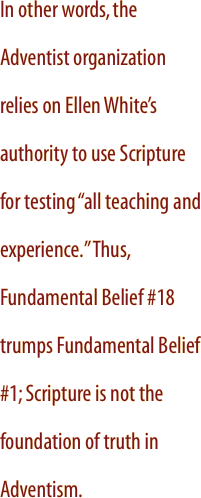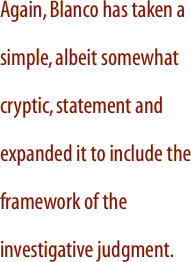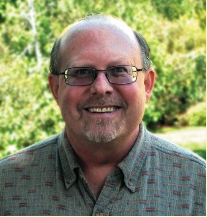
Editor’s Note: This article is excerpted from a new book by Stephen Pitcher on The Clear Word, a paraphrase of the Bible by Jack Blanco, which is being prepared for publication. In this article Stephen shows how the Adventist Fundamental Belief concerning the gift of prophecy as it relates to Ellen White compromises its Fundamental Belief concerning the sufficiency of Scripture. This compromise grows out of Adventism’s unique belief in the nature of inspiration, and ultimately, Adventism uses Ellen White as an inspired source of truth. Because of Adventism’s belief in the authority of Ellen White’s revelations, her writings are, in practice, the interpreter of Scripture.
HOME / PROCLAMATION! MAGAZINE / 2013 / SUMMER / PITCHER


STEPHEN PITCHER
The way a church understands and uses the Bible reveals whether or not that group uses Scripture as its sole foundation for doctrine, for practice, and for its worldview. A cursory reading of the first Fundamental Belief of the Seventh-day Adventist Church might suggest that Adventism views Scripture much as many evangelicals do:
1. The Holy Scriptures: The Holy Scriptures, Old and New Testaments, are the written Word of God, given by divine inspiration through holy men of God who spoke and wrote as they were moved by the Holy Spirit. In this Word, God has committed to man the knowledge necessary for salvation. The Holy Scriptures are the infallible revelation of His will. They are the standard of character, the test of experience, the authoritative revealer of doctrines, and the trustworthy record of God’s acts in history.1
A casual reader would assume that Adventism uses the Bible and the Bible alone as its sole source of authority. A closer look at the first fundamental belief, however, reveals that Adventism does not hold the Bible to be inerrant, without error in the original manuscripts. Moreover, as we examine passages from The Clear Word (TCW) that address certain beliefs of the Seventh-day Adventist Church and compare those with the same passages from the English Standard Version (ESV), we will see that the Old and New Testaments are not the only sources from which Adventism obtains its doctrines.
The concealed truth is that within Adventism, the position of the Bible as stated in Fundamental Belief #1 is compromised by Fundamental Belief #18 which describes Adventism’s unique understanding of the “gift of prophecy”. Although the first Adventist fundamental belief states that the Bible is “infallible” and the “authoritative revealer of doctrines”, its eighteenth fundamental belief clearly states that Adventist prophet Ellen White is “a continuing and authoritative source of truth”. The statement reads:
18. The Gift of Prophecy: One of the gifts of the Holy Spirit is prophecy. This gift is an identifying mark of the remnant church and was manifested in the ministry of Ellen G. White. As the Lord’s messenger, her writings are a continuing and authoritative source of truth which provide for the church comfort, guidance, instruction, and correction. They also make clear that the Bible is the standard by which all teaching and experience must be tested.2
Notice that Ellen White’s gift of prophecy is an “identifying mark of the remnant church”, the self-proclaimed identity of the Seventh-day Adventist Church. In addition, it is Ellen White’s writings that state the “Bible is the standard by which all teaching and experience must be tested.” In other words, the Adventist organization relies on Ellen White’s authority to use Scripture for testing “all teaching and experience.” Thus, Fundamental Belief #18 trumps Fundamental Belief #1; Scripture is not the foundation of truth in Adventism.
Additionally, Ellen White herself adapted Hebrews 1:1-2, which identifies the Lord Jesus as the final and full revelation of God to mankind, to describe her own revelations. Here is Hebrews 1:1-2a:
Long ago, at many times and in many ways, God spoke to our fathers by the prophets, but in these last days he has spoken to us by his Son…
Now, compare Hebrews 1:1-2 with Ellen White’s description of her own “testimonies”. Significantly, this statement is quoted from her series of books entitled Testimonies For the Church:
In ancient times God spoke to men by the mouth of prophets and apostles. In these days He speaks to them by the testimonies of His Spirit. There was never a time when God instructed His people more earnestly than He instructs them now concerning His will and the course that He would have them pursue. [Vol. 4, pp. 147, 148 (1876).]
The Lord has seen fit to give me a view of the needs and errors of His people. Painful though it has been to me, I have faithfully set before the offenders their faults and the means of remedying them. …Thus has the Spirit of God pronounced warnings and judgments, withholding not, however, the sweet promise of mercy…3
TCW: clarifying or confusing?
TCW is a paraphrase which incorporates Ellen White’s teachings into the words of Scripture. If, as the publisher of TCW says, this paraphrase makes Scripture’s meaning more transparent, it should not be difficult to test this premise by comparing its words with those of an accepted translation. Upon looking, however, one finds that the text of TCW confuses otherwise simple and clear statements of Scripture. In fact, instead of clarifying Scripture, TCW reveals that Adventist doctrine depends upon the testimonies of Ellen White.
Because TCW incorporates the extra-biblical ideas of the prophet Ellen White, we will look first at how it handles Revelation 22:18 which prohibits adding or subtracting anything from God’s word.
Revelation 22:18
The Easy English Clear Word and The Clear Word for Kids
I, John, the apostle, warn everyone who reads this book not to change these prophecies. If they do, the plagues of this book will fall on them.
The Clear Word
I, John, warn everyone who reads or hears the prophetic words in this book not to add anything contrary to what is written. If they do, God’s seven last plagues will certainly fall on them.
English Standard Version
I warn everyone who hears the words of the prophecy of this book: if anyone adds to them, God will add to him the plagues described in this book.
The verse from TCW specifically allows additions to Scripture as long as those additions are not contrary to what is already written. This altered rendering allows the author to manipulate the biblical text however he wishes in order to support Adventist doctrine. The author, in fact, becomes the final authority on what the text says rather than allowing the text itself to remain the standard. Blanco knew that incorporating Ellen White’s great controversy worldview into Scripture would add to the original text, so he inserted the “anything contrary” phrase to justify his additions. It is impossible to compare this TCW paraphrase with the same verse from the Bible without seeing that the paraphrased version is condemned.
Importantly, The Easy English Clear Word (TEECW) and The Clear Word for Kids (TCWFK) do not even warn against “adding” to Scripture. They only warn readers not to “change” the prophecies. Unsuspecting Adventist children or adults for whom English is a second language would have no idea that the text of their version of TCW has been changed; it would agree with the Adventist worldview which they had learned from the beginning.
There is one other significant passage in TEECW and TCWFK related to altering the words of Scripture. Notice the following comparison of Revelation 22:19:
Revelation 22:19
The Easy English Clear Word and The Clear Word for Kids
If anyone dismisses part of this book with its prophecies as not being important, God will take away his right to the city and to the tree of life I have written about.
English Standard Version
…and if anyone takes away from the words of the book of this prophecy, God will take away his share in the tree of life and in the holy city, which are described in this book.
In this verse Blanco removes the warning about taking away words and replaces it with “If anyone dismisses …” This change justifies Blanco’s removal of substantial material from the Bible to create his “simplified paraphrases”, (The Easy English Clear Word and The Clear Word for Kids.) He can, therefore, argue that his simplifications do not dismiss any of the meanings of the Scriptural passages.
The Adventist Trinity
For examples of Blanco’s scriptural changes for the support of Adventist doctrine, let’s begin in Genesis where he describes a physical, non-trinitarian deity.
Genesis 1:26-27
The Easy English Clear Word and The Clear Word for Kids
Then God said to His Son, “Let us make people who look like Us, and put them in charge of all the animals and fish and birds.” So God created a man and a woman.
The Clear Word
But this was not the end of His work for that day. Next He said to His Son, “Now let us make beings who look like us and can reflect our thinking and our personality. Let’s give them the responsibility of ruling over and caring for the fish, the birds and the animals we created.” So they created two human beings, a male and a female, equal but with different functions to reflect the unity of the Godhead.
English Standard Version
Then God said, “Let us make man in our image, after our likeness. And let them have dominion over the fish of the sea and over the birds of the heavens and over the livestock and over all the earth and over every creeping thing that creeps on the earth.” So God created man in his own image, in the image of God he created him; male and female he created them.
God is spirit (Jn. 4:24), and the Father, Son and Holy Spirit are one God—one Being. Understanding this fact, we can understand that the “image” in which man is made is spiritual, not physical. Blanco’s rendering, however, indicates that human beings “look like” the Father and Son, as though they have physical characteristics. Moreover, Blanco separates God from the Son, thus eliminating the unity of the Trinity—but he doesn’t stop there. Since Blanco adds “His Son”, we would expect him similarly to name the Spirit, but he does not. Thus, in the first chapter of Genesis, Blanco reveals his anti-trinitarian bias derived from Adventism’s founders.
Early Adventism was anti-trinitarian, and most of the founders taught that the Spirit was not a person but a force. Moreover, early Adventism also taught that, before the incarnation, the Son and the Father each had a body like ours and passions. For example, James White wrote:
The way spiritualizers this way have disposed of or denied the only Lord God and Lord Jesus Christ is first using the old unscriptural trinitarian creed, viz, that Jesus Christ is the eternal God, though they have not one passage to support it, while we have plain scripture testimony in abundance that he is the Son of the eternal God. Then they dispense of Jesus; secondly, by quoting John 4:24. God is a spirit, and as they assert, nothing but a spirit, the Holy Ghost, which dwells in a Christian. Thus they dispose of the Almighty God, while I can and will show from two texts of the Bible that they both exist with body and parts…The ancient of days, or God, has a head, and hair on his head like the pure wool.4
Ellen White also denied the trinitarian creed. Adventist scholars Whidden, Moon, and Reeve wrote this in their book The Trinity:
It is possible that when her earlier visions contradicted some aspects of her Methodist upbringing (the creed that said God had neither body nor parts), she might have put the rest of her Methodist Trinity views “on the shelf,” so to speak …5
Ellen White evidently agreed with her husband that Christ and the Father were “two distinct, literal, tangible persons,” but we have no record … of her explicitly criticizing any Trinitarian view as did her husband.6
These foundational beliefs still color the Adventist understanding of God, and in the first chapter of Genesis, TCW presents us with a physical, bitheistic Godhead, a view which both reflects historic Adventism and allows Adventists to hold non-trinitarian or tritheistic positions today.
The fall
Just two chapters in from the twisting of God’s identity into a physical bitheism, Blanco seriously alters the details of our first parents’ sin. Blanco draws from the writings of Ellen G. White (EGW) to change and expand a text from Genesis 3.
Genesis 3:6
The Easy English Clear Word and The Clear Word for Kids
Instead of running back to her husband, Eve lingered at the tree. The fruit looked delicious! Then she touched it and nothing happened. So she took a bite. Excited, she ran to tell her husband. From this, Adam knew that Eve would die, so he took the fruit and ate it to die with her.
The Clear Word
As Eve watched the serpent eat the delicious fruit, she suddenly felt a strong urge to taste it too. She reached out and touched the fruit and nothing happened. Then she picked it, took a bite and instantly felt a surge of energy. Excited, she took more fruit and ran to find her husband. When Adam saw her, he sensed what she had done. But in the blush of her excitement, she looked more beautiful than ever. He couldn’t bear the thought of living without her, so he took the fruit and ate it also.
English Standard Version
So when the woman saw that the tree was good for food, and that it was a delight to the eyes, and that the tree was to be desired to make one wise, she took of its fruit and ate, and she also gave some to her husband who was with her, and he ate.
It doesn’t take an expert to identify the amount of addition to the Bible that has been done in this passage. One of the most obvious changes is Blanco’s moving of Adam from being “with her” to being somewhere away from Eve. Where did Blanco obtain those details and the authority to include them in TCW? The writings of Ellen G. White, prophetess of the Seventh-day Adventist Church, are the source of Blanco’s rendering:
She then plucked for herself of the fruit and ate, and imagined she felt the quickening power of a new and elevated existence as the result of the exhilarating influence of the forbidden fruit. She was in a strange and unnatural excitement as she sought her husband, with her hands filled with the forbidden fruit. She related to him the wise discourse of the serpent, and wished to conduct him at once to the tree of knowledge. She told him she had eaten of the fruit, and instead of her feeling any sense of death, she realized a pleasing, exhilarating influence. As soon as Eve had disobeyed, she became a powerful medium through which to occasion the fall of her husband.
I saw a sadness come over the countenance of Adam. He appeared afraid and astonished. A struggle appeared to be going on in his mind. He told Eve he was quite certain that this was the foe that they had been warned against; and if so, that she must die. She assured him she felt no ill effects, but rather a very pleasant influence, and entreated him to eat.7
Blanco’s Ellen White-inspired expansion takes a passage of 55 words in the ESV and expands it to 95 words in TCW. This is not a clarification of the passage. Rather, White/Blanco have removed Adam from the scene, have glorified sin by describing Eve exuding a compelling excitement, and have suggested that Adam was vulnerable to lust and co-dependence as he succumbed to his seductive wife. TCW tells a completely different story from the Bible.
Adventism’s central pillar
Blanco’s interpretation of Daniel 8:14 is one of TCW’s most egregious additions to Scripture. This is the proof-text for the investigative judgment, Adventism’s central pillar of doctrine. This passage in all translations of Scripture give no hint of the convoluted details Adventism imposes on the text. Blanco, however, writes Adventism into the verse:
Daniel 8:14
The Clear Word
He answered, “After two thousand, three hundred prophetic days (which represent actual years), God will restore the truth about the heavenly sanctuary to its rightful place. Then the process of judgment will begin of which the yearly cleansing of the earthly Sanctuary was a type, and God will vindicate His people.”
English Standard Version
And he said to me, “For 2,300 evenings and mornings. Then the sanctuary shall be restored to its rightful state.”
One would need to attend an Adventist prophecy seminar in order to unpack the words in this expanded “paraphrase” of Daniel 8:14. Again, Blanco has taken a simple, albeit somewhat cryptic, statement and expanded it to include the framework of the investigative judgment. For Adventists reading TCW, moreover, this expansion would likely give them a sense of relief because it would seem that their most confusing doctrine actually has scriptural support. The Bible, however, would increase cognitive dissonance that could eventually drive one to search the Scriptures to see if these things are so.
Adventism and Inspiration
Jack Blanco was able to write Adventist doctrine into TCW because of Adventism’s doctrine of inspiration. Adventists do not endorse the verbal inspiration of the Bible because Adventism teaches that Ellen G. White was inspired in exactly the same way as were the Bible writers: the Lord gave thoughts and ideas to the authors who then used their own skills to generate the words they used to explain those thoughts and ideas. Thus, Adventism can continue to promote the Spirit of Prophecy as being inspired just as was the Bible. Roger Coon from The White Estate explains it this way:
What, then, is the position of the denomination with regard to the proper relationship between the writings of Mrs. White and sacred Scripture? As I understand it, we hold that Ellen G. White was inspired in the same manner and to the identical degree as were the prophets of the Bible; but—and this will be paradoxical to some—we do not make of her writings a second Bible, or even an addition to the sacred canon of God’s Word.8
This explanation is double-speak. Adventists live with cognitive dissonance because they are told that Ellen White’s writings are not on the level of Scripture. At the same time, they are also told that the Spirit of Prophecy is inspired in the same manner and to the same degree as Scripture. Both of these claims cannot be true.
This double-speak is compounded by the fact that official Adventist statements do not reveal the way Ellen White’s writings are actually used within Adventism.
To further understand Adventism’s claims, let’s take a look at how the Biblical Research Institute (BRI) of Seventh-day Adventism and Ellen White explain inspiration. First, here is White’s classical statement:
It is not the words of the Bible that are inspired, but the men that were inspired. Inspiration acts not on the man’s words or his expressions but on the man himself, who, under the influence of the Holy Ghost, is imbued with thoughts. But the words receive the impress of the individual mind. The divine mind is diffused. The divine mind and will is combined with the human mind and will; thus the utterances of the man are the word of God.9
The BRI endorses White’s revelation:
According to her, God addresses the totality of the person and not only one aspect of the personality of the prophets, e.g. the verbal skills of the prophets. Second, what she is describing is the mysterious process through which the divine message or word is “incarnated” into the human condition. The divine mind, she says, is diffused. And by that she means that the divine mind and will are combined with the human mind and will in such a way that what is expressed by the human instrument—“the utterances of the man”—are “the word of God.”10
George Knight, retired Adventist historian and former professor at Andrews Theological Seminary, writes the following in his book, Reading Ellen White:
The same kind of factual errors can be discovered in Ellen White’s writings as are found in the Bible. The writings of God’s prophets are infallible as a guide to salvation, but they are not inerrant or without error. Part of the lesson is that we need to read for the central lessons of Scripture and Ellen White rather than the details.11
Jack Blanco agrees with the above ideas. In 1993 he wrote an article for the Journal of the Adventist Theological Society. There he states,
The words of the Bible are not inspired, but the men who wrote them were.12
The Christian position
In contrast to Adventism, evangelical Christianity endorses both the verbal inspiration and the inerrancy of the Scriptures. Following are a few statements on biblical inerrancy from the Chicago Statement on Biblical Inerrancy, created in 1978.
A Short Statement
- God, who is Himself Truth and speaks truth only, has inspired Holy Scripture in order thereby to reveal Himself to lost mankind through Jesus Christ as Creator and Lord, Redeemer and Judge. Holy Scripture is God’s witness to Himself.
- Holy Scripture, being God’s own Word, written by men prepared and superintended by His Spirit, is of infallible divine authority in all matters upon which it touches: it is to be believed, as God’s instruction, in all that it affirms: obeyed, as God’s command, in all that it requires; embraced, as God’s pledge, in all that it promises.
- The Holy Spirit, Scripture’s divine Author, both authenticates it to us by His inward witness and opens our minds to understand its meaning.
- Being wholly and verbally God-given, Scripture is without error or fault in all its teaching, no less in what it states about God’s acts in creation, about the events of world history, and about its own literary origins under God, than in its witness to God’s saving grace in individual lives.
- The authority of Scripture is inescapably impaired if this total divine inerrancy is in any way limited or disregarded, or made relative to a view of truth contrary to the Bible’s own; and such lapses bring serious loss to both the individual and the Church.13
Following the “Short Statement” are 19 affirmations and denials which summarize the evangelical understanding of inspired Scripture. Major points include that God used human language to reveal His will, and God’s intention has not been thwarted or corrupted through the changes of language.
Moreover, God the Holy Spirit inspired human writers and gave them His Word. While revelation is a mystery, we do not believe that it is merely human insight nor “heightened states of consciousness of any kind.” God did not override human personalities while He gave them the words He chose.
Furthermore, inspiration guarantees that there is no distortion of falsehood in the words of Scripture. Even though the writers are human, God is in charge of the words He gave. Finally, because God inspired Scripture, it is infallible and inerrant. It cannot lead a person astray, and there are no false statements. The Bible cannot be infallible and errant at the same time. While infallibility and inerrancy may be distinguished, they cannot be separated.14
Ellen White’s real role
If the Bible and the Spirit of Prophecy are equally inspired by God, then they must be, by nature, of equal value to the reader. The Adventist organization verbally denies what it actually confirms in practice. Ellen White is used to answer questions of faith and practice, to provide counsel for those facing difficulties, and is used to end disagreements, i.e., where Ellen White speaks on a topic, that is the final word. No matter what the Bible says, in practice Ellen White is both the source and end of truth for the Seventh-day Adventist Church.
At the 56th General Conference of Seventh-day Adventists a “statement of confidence in the Spirit of Prophecy” was passed. It specifically states how Ellen G. White is to be used.
We, the delegates assembled in Utrecht for the fifty-sixth session of the General Conference of Seventh-day Adventists … recommend …
1) That as a church we seek the power of the Holy Spirit to apply to our lives more fully the inspired counsel contained in the writings of Ellen G White, and
2) That we make increased efforts to publish and circulate these writings throughout the world.
Within Adventism, Ellen White is more than just a Christian writer like any other devotional author. Rather, her words hold authority over the beliefs and practices of the Seventh-day Adventist organization. As affirmed in Fundamental Belief #18, “Her writings are a continuing and authoritative source of truth which provide for the church comfort, guidance, instruction, and correction.” This statement sounds eerily like 2 Timothy 3:16; “All Scripture is breathed out by God and profitable for teaching, for reproof, for correction, and for training in righteousness.” In reality, Ellen White’s writings hold the same authority for a Seventh-day Adventist as does the Bible for the Christian.
Jack Blanco demonstrated the Adventist dependence upon Ellen White when he incorporated her teachings directly into the Adventist paraphrase of Scripture, The Clear Word. The Adventist organization has further endorsed its dependence upon her writings by marketing TCW in its Adventist Book Centers and on its websites as a Bible, advertising it as a viable paraphrase useful for devotional reading.
Conclusion
Jack Blanco chose to ignore the warning of Revelation 22:18 when he wrote The Clear Word. If he did not believe that Ellen White’s writings were God-inspired and valid for interpreting Scripture, He would not have dared to change that verse—and countless other passages throughout the Bible—so that his paraphrase agrees with Seventh-day Adventism and with Ellen G. White.
If there is no difference in manner or degree of inspiration between the Bible writers and Ellen White, it doesn’t matter what the official Adventist position states about the status of her works. In practice, Adventism uses her writings as if they are on a par with Scripture. The writings of Ellen White are a “continuing and authoritative source of truth” and, therefore, must be consulted when seeking answers about the faith and practice of Adventist life. †
Endnotes
- Ministerial Association, General Conference of Seventh-day Adventists, Seventh-day Adventists Believe, 2nd Ed., 2005, p. 11.
- Ibid., p. 247.
- White, Ellen G., Testimonies for the Church, Vol. 5, (1882-1889), p. 661. Ellipses in original. [The bracketed note is in the original and is referring to volume 4 of this series.] From the EGW Comprehensive Research Edition CD ROM, E. G.. White Estate, 2008.
- White, James, The Day-Star, Jan. 24, 1846, p. 1 (Capitalization as in the original.)
- Whidden, Woodrow; Moon, Jerry; Reeve John W., The Trinity, Review and Herald® Publishing Association, 2002, p. 211.
- Ibid., p. 207.
- White, Ellen G., Spiritual Gifts, Vol. 1, p. 38-39.
- Coon, Roger W., from the website, http://www.whiteestate.org/issues/rev-insp.html #part3, emphasis in original, online as of 6/4/13.
- Selected Messages, Vol. 1, p. 21 (Manuscript 24, 1886; written in Europe in 1886).
- From the Adventist Biblical Research website – https://adventistbiblicalresearch.org/materials/bible/issues-revelation-and-inspiration, online as of 6/4/13.
- Knight, George R., Reading Ellen White, copyright © 1997 by Review and Herald® Publishing Association, p. 111.
- Blanco, Jack J., “Faith and Theology,” Journal of the Adventist Theological Society, April 2, 1993, p. 32.
- “The 1978 Chicago Statement on Biblical Inerrancy,” as contained in Grudem, Wayne, Systematic Theology, 1994, p. 1204.
- “The 1978 Chicago Statement on Biblical Inerrancy,” as contained in Grudem, Wayne, Systematic Theology, pp. 1203-1207, 1994.

Copyright 2013 Life Assurance Ministries, Inc., Casa Grande, Arizona, USA. All rights reserved. Revised July 10, 2013. Contact email: proclamation@gmail.com
S U M M E R • 2 0 1 3
VOLUME 14, ISSUE 2


 Stephen Pitcher became a Christian at age 17 through the ministry of Young Life and was baptized in a Baptist church. He later converted to Adventism which he left after 18 years. He currently attends Trinity Evangelical Free Church in Redlands, California, where he is a member. He continues a 37-year study of cults, world religions, and the occult from his home in Yucaipa, California.
Stephen Pitcher became a Christian at age 17 through the ministry of Young Life and was baptized in a Baptist church. He later converted to Adventism which he left after 18 years. He currently attends Trinity Evangelical Free Church in Redlands, California, where he is a member. He continues a 37-year study of cults, world religions, and the occult from his home in Yucaipa, California.